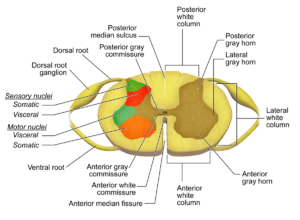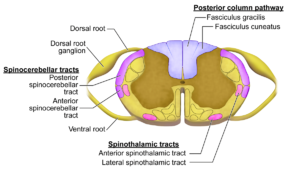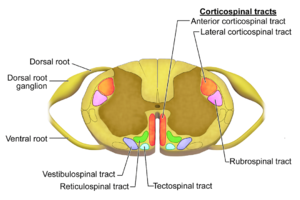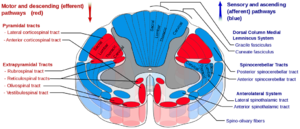Spinal Cord Anatomy: Difference between revisions
(Created page with "{{stub}} The spinal cord starts below the '''foramen magnum''', and ends at the tip of the '''conus medullaris'''. It ends between the T12 to L2-3 disc level, typically around...") |
No edit summary |
||
| Line 2: | Line 2: | ||
The spinal cord starts below the '''foramen magnum''', and ends at the tip of the '''conus medullaris'''. It ends between the T12 to L2-3 disc level, typically around L1 or the L1-2 disc. It is contained within the thecal sac. The spinal cord has a tubular shape. On cross section it is elliptical in the cervical region, and round in the thoracic region. There are two enlargements at the areas of limb innervation - the cervical enlargement at C5-T1 for upper limb innervation, and a smaller lumbar enlargement at T9-L2 for lower limb and pelvis innervation. There are 31 spinal segments along the spinal cord. These are the 8 cervical, 12 thoracic, five lumbar, five sacral, and one coccygeal segments. The '''filum terminalis''' is a thin band of connective tissue that extends from the tip of the conus medullaris down to the first coccygeal segment through the caudal end of the thecal sac.{{#pmid:29995620|kunam}} | The spinal cord starts below the '''foramen magnum''', and ends at the tip of the '''conus medullaris'''. It ends between the T12 to L2-3 disc level, typically around L1 or the L1-2 disc. It is contained within the thecal sac. The spinal cord has a tubular shape. On cross section it is elliptical in the cervical region, and round in the thoracic region. There are two enlargements at the areas of limb innervation - the cervical enlargement at C5-T1 for upper limb innervation, and a smaller lumbar enlargement at T9-L2 for lower limb and pelvis innervation. There are 31 spinal segments along the spinal cord. These are the 8 cervical, 12 thoracic, five lumbar, five sacral, and one coccygeal segments. The '''filum terminalis''' is a thin band of connective tissue that extends from the tip of the conus medullaris down to the first coccygeal segment through the caudal end of the thecal sac.{{#pmid:29995620|kunam}} | ||
[[File:Spainal cord sectional anatomy.png|thumb|right|Spinal cord sectional anatomy]] | |||
A deep '''ventral median fissure''' and a shallower '''dorsal median sulcus''' and septum posteriorly divides the spinal cord into right and left halves that are almost completely separated. Dorsal nerve roots travel to the cord on the posterior surface of the cord through the '''dorsolateral sulci'''. Ventral nerve roots travel from the anterior surface of the cord through the '''ventrolateral sulci'''. The topography of the cord surface can be visualised by axial T2 weighted gradient echo MRI sequences and CT myelograms.<ref name="kunam"/> | A deep '''ventral median fissure''' and a shallower '''dorsal median sulcus''' and septum posteriorly divides the spinal cord into right and left halves that are almost completely separated. Dorsal nerve roots travel to the cord on the posterior surface of the cord through the '''dorsolateral sulci'''. Ventral nerve roots travel from the anterior surface of the cord through the '''ventrolateral sulci'''. The topography of the cord surface can be visualised by axial T2 weighted gradient echo MRI sequences and CT myelograms.<ref name="kunam"/> | ||
Unlike the brain where the grey matter is located peripherally, the spinal cord has its grey matter centrally and is H- or butterfly-shaped. On MRI the grey matter is hyperintense on T2, and hypointense on T1. The peripheral white matter columns are hyperintense to grey on T1. The grey matter has '''ventral and dorsal horns''' that run along the length of the cord. There are also small '''lateral horns''' from around T1-L1. The dorsal horns receive primary afferent fibres from the dorsal roots of the spinal nerves and are primarily involved in sensory processing. The ventral horns transmit motor neurons. The lateral horns have autonomic nuclei and interneurons. Connecting the two arms of the H around the central canal are the '''ventral and dorsal gray matter commissures''' that run horizontally. The '''central canal''' is located between the ventral one-third and dorsal two-thirds in the cervical and thoracic region, and is more central in the lumbar region. On MRI it is a thin with a non-enhancing fluid signal.<ref name="kunam"/> | Unlike the brain where the grey matter is located peripherally, the spinal cord has its grey matter centrally and is H- or butterfly-shaped. On MRI the grey matter is hyperintense on T2, and hypointense on T1. The peripheral white matter columns are hyperintense to grey on T1. The grey matter has '''ventral and dorsal horns''' that run along the length of the cord. There are also small '''lateral horns''' from around T1-L1. The dorsal horns receive primary afferent fibres from the dorsal roots of the spinal nerves and are primarily involved in sensory processing. The ventral horns transmit motor neurons. The lateral horns have autonomic nuclei and interneurons. Connecting the two arms of the H around the central canal are the '''ventral and dorsal gray matter commissures''' that run horizontally. The '''central canal''' is located between the ventral one-third and dorsal two-thirds in the cervical and thoracic region, and is more central in the lumbar region. On MRI it is a thin with a non-enhancing fluid signal.<ref name="kunam"/> | ||
The white matter contains three columns otherwise known as funiculi. They are the ventral (anterior), lateral, and dorsal (posterior) columns. They contain nerve axon bundles making up the neural pathways. The '''ventral columns''' are located between the ventral median fissure and ventral nerve roots. The '''lateral columns''' are between the ventrolateral and dorsolateral sulci in the location of where the ventral nerve roots exit and the dorsal nerve roots enter the cord. The '''dorsal columns''' are between the dorsal median sulcus and dorsolateral sulci on each side. Through these columns travel the ascending sensory and descending motor pathways. The most well known columns are the corticospinal tract, the dorsal columns, and the spinothalamic tract.<ref name="kunam"/> | The white matter contains three columns otherwise known as funiculi. They are the ventral (anterior), lateral, and dorsal (posterior) columns. They contain nerve axon bundles making up the neural pathways. The '''ventral columns''' are located between the ventral median fissure and ventral nerve roots. The '''lateral columns''' are between the ventrolateral and dorsolateral sulci in the location of where the ventral nerve roots exit and the dorsal nerve roots enter the cord. The '''dorsal columns''' are between the dorsal median sulcus and dorsolateral sulci on each side. Through these columns travel the ascending sensory and descending motor pathways. The most well known columns are the corticospinal tract, the dorsal columns, and the spinothalamic tract.<ref name="kunam"/> | ||
<gallery widths=300px heights=200px> | |||
Spinal cord sensory pathways.png|Spinal cord sensory pathways | |||
Spinal cord motor pathways.png|Spinal cord motor pathways | |||
Vestibulospinal tract.png|Spinal cord detailed pathways | |||
</gallery> | |||
==References== | ==References== | ||
Revision as of 09:16, 17 May 2021
The spinal cord starts below the foramen magnum, and ends at the tip of the conus medullaris. It ends between the T12 to L2-3 disc level, typically around L1 or the L1-2 disc. It is contained within the thecal sac. The spinal cord has a tubular shape. On cross section it is elliptical in the cervical region, and round in the thoracic region. There are two enlargements at the areas of limb innervation - the cervical enlargement at C5-T1 for upper limb innervation, and a smaller lumbar enlargement at T9-L2 for lower limb and pelvis innervation. There are 31 spinal segments along the spinal cord. These are the 8 cervical, 12 thoracic, five lumbar, five sacral, and one coccygeal segments. The filum terminalis is a thin band of connective tissue that extends from the tip of the conus medullaris down to the first coccygeal segment through the caudal end of the thecal sac.[1]
A deep ventral median fissure and a shallower dorsal median sulcus and septum posteriorly divides the spinal cord into right and left halves that are almost completely separated. Dorsal nerve roots travel to the cord on the posterior surface of the cord through the dorsolateral sulci. Ventral nerve roots travel from the anterior surface of the cord through the ventrolateral sulci. The topography of the cord surface can be visualised by axial T2 weighted gradient echo MRI sequences and CT myelograms.[1]
Unlike the brain where the grey matter is located peripherally, the spinal cord has its grey matter centrally and is H- or butterfly-shaped. On MRI the grey matter is hyperintense on T2, and hypointense on T1. The peripheral white matter columns are hyperintense to grey on T1. The grey matter has ventral and dorsal horns that run along the length of the cord. There are also small lateral horns from around T1-L1. The dorsal horns receive primary afferent fibres from the dorsal roots of the spinal nerves and are primarily involved in sensory processing. The ventral horns transmit motor neurons. The lateral horns have autonomic nuclei and interneurons. Connecting the two arms of the H around the central canal are the ventral and dorsal gray matter commissures that run horizontally. The central canal is located between the ventral one-third and dorsal two-thirds in the cervical and thoracic region, and is more central in the lumbar region. On MRI it is a thin with a non-enhancing fluid signal.[1]
The white matter contains three columns otherwise known as funiculi. They are the ventral (anterior), lateral, and dorsal (posterior) columns. They contain nerve axon bundles making up the neural pathways. The ventral columns are located between the ventral median fissure and ventral nerve roots. The lateral columns are between the ventrolateral and dorsolateral sulci in the location of where the ventral nerve roots exit and the dorsal nerve roots enter the cord. The dorsal columns are between the dorsal median sulcus and dorsolateral sulci on each side. Through these columns travel the ascending sensory and descending motor pathways. The most well known columns are the corticospinal tract, the dorsal columns, and the spinothalamic tract.[1]
References
Literature Review
- Reviews from the last 7 years: review articles, free review articles, systematic reviews, meta-analyses, NCBI Bookshelf
- Articles from all years: PubMed search, Google Scholar search.
- TRIP Database: clinical publications about evidence-based medicine.
- Other Wikis: Radiopaedia, Wikipedia Search, Wikipedia I Feel Lucky, Orthobullets,






